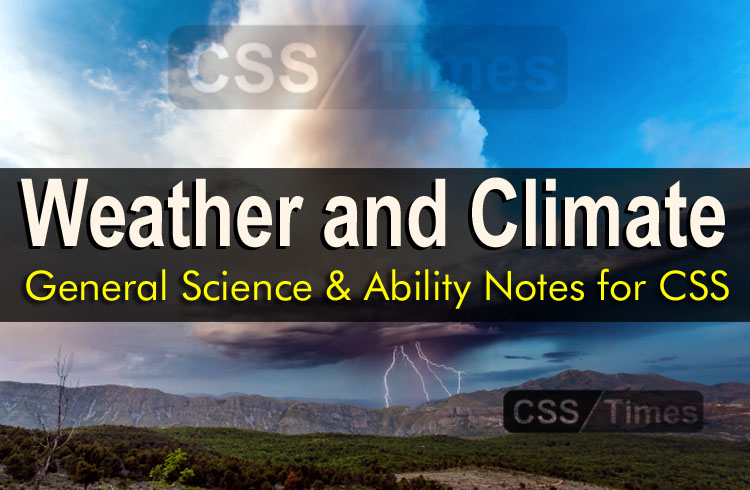Weather and Climate
What is weather?
Weather describes the condition of the atmosphere over a short period of time e.g. from day to day or week to week, while climate describes average conditions over a longer period of time. Step outside and you experience many facets of weather. Humidity, air temperature and pressure, wind speed and direction, cloud cover and type, and the amount and form of precipitation are all atmospheric characteristics of the momentary conditions we call weather.
The sun is ultimately responsible for the weather. Its rays are absorbed differently by land and water surfaces (equal amounts of solar radiation heat the ground more quickly than they do water). Differential warming, in turn, causes variations in the temperature and pressure of overlying air masses.
As an air mass warms, it becomes lighter and rises higher into the atmosphere. As an air mass cools, it becomes heavier and sinks. Pressure differences between masses of air generate winds, which tend to blow from high-pressure areas to areas of low pressure. Fast-moving, upper atmosphere winds known as jet streams help move weather systems around the world.
What is climate?
It has been said that “climate is what you expect; weather is what you get”. In other words, you can expect snow in Pakistan in January, but you may or may not get it on a particular day.
The climate of an area or country is known through the average weather over a long period of time. If an area has more dry days throughout the year than wet days, it would be described as a dry climate; a place which has more cold days than hot days would make it known to have a cold climate.
Factors that Influence Weather
There are many factor that influence weather, many of which we cannot see.
The Water Cycle
As the sun warms the surface of the Earth, water rises in the form of water vapor from lakes, rivers, oceans, plants, the ground, and other sources. This process is called evaporation.
Water vapor provides the moisture that forms clouds; it eventually returns to Earth in the form of precipitation, and the cycle continues.
Air Masses
When air hovers for a while over a surface area with uniform humidity and temperature, it takes on the characteristics of the area below. For example, an air mass over the tropical Atlantic Ocean would become warm and humid; an air mass over the winter snow and ice of northern Canada would become cold and dry. These massive volumes of air often cover thousands of miles and reach to the stratosphere. Overtime, mid-latitude cyclonic storms and global wind patterns move them to locations far from their source regions.
What happens when 2 air masses meet? The cold air pushes the hot air upwards, when going up the temperature drops and the air can’t hold as much water when it is warm, so the cold water molecules condense and form clouds.
Jet Stream
A jet stream is the name given to the area of air above where two air masses of different temperature converge e.g. a cold front meeting a warm front. The greater the temperature difference between the air masses, the greater the air pressure difference, and the faster the wind blows in the jet stream. This river of air has wind speeds which often exceed 100 mph, and sometimes over 200 mph. Jet streams more commonly form in the winter, when there is a greater difference between the temperature of the cold continental air masses and warm oceanic air masses.
This meandering current of high-speed wind, a jet stream is usually found around five to ten miles above Earth’s surface.
Weather Fronts
The transition zone between two air masses of different humidity and temperature is called a front. Along a cold front, cold air displaces warm air; along a warm front, warm air displaces cold air. When neither air mass displaces the other, a stationary front develops. Towering clouds and intense storms may form along cold fronts, while widespread clouds and rain, snow, sleet, or drizzle may accompany warm fronts.
Elements of Weather
The elements of weather include temperature, humidity, cloudiness, precipitation, wind, and pressure. These elements are organized into various weather systems, such as monsoons, areas of high and low pressure, thunderstorms, and tornadoes. All weather systems have well-defined cycles and structural features and are governed by the laws of heat and motion. These conditions are studied in meteorology, the science of weather and weather forecasting.
Weather differs from climate, which is the weather that a particular region experiences over a long period of time. Climate includes the averages and variations of all-weather elements.
1) Temperature
Temperature is a measure of the degree of hotness of the air. Three different scales are used for measuring temperature. Scientists use the Kelvin, or absolute, scale and the Celsius, or centigrade, scale. Most nations use the Celsius scale, although the United States continues to use the Fahrenheit scale.
Temperature on earth averages 15° C (59° F) at sea level but varies according to latitude, elevation, season, and time of day, ranging from a record high of 58° C (140° F) to a record low of -88° C (-130° F). Temperature is generally highest in the Tropics and lowest near the poles. Each day it is usually warmest during midafternoon and coldest around dawn.
Seasonal variations of temperature are generally more pronounced at higher latitudes. Along the equator, all months are equally warm, but away from the equator, it is generally warmest about a month after the summer solstice (around June 21 in the northern hemisphere and around December 21 in the southern hemisphere) and coldest about a month after the winter solstice (around December 21 in the northern hemisphere and around June 21 in the southern hemisphere). Temperature can change abruptly when fronts (boundaries between two air masses with different temperatures or densities) or thunderstorms pass overhead.
Temperature decreases with increasing elevation at an average rate of about 6.5° C per km (about 19° F per mi). As a result, temperatures in the mountains are generally much lower than at sea level.
Temperature continues to decrease throughout the atmosphere’s lowest layer, the troposphere, where almost all weather occurs.
2) Humidity
Humidity is a measure of the amount of water vapor in the air. The air’s capacity to hold vapor is limited but increases dramatically as the air warms, roughly doubling for each temperature increase of 10° C (18° F). There are several different measures of humidity. The specific humidity is the fraction of the mass of air that consists of water vapor, usually given as parts per thousand. Even the warmest, most humid air seldom has a specific humidity greater than 20 parts per thousand. The most common measure of humidity is the relative humidity, or the
amount of vapor in the air divided by the air’s vapor-holding capacity at that temperature. If the amount of water vapor in the air remains the same, the relative humidity decreases as the air is heated and increases as the air is cooled. As a result, relative humidity is usually highest around dawn, when the temperature is lowest, and lowest in midafternoon, when the temperature is highest.
3) Cloudiness
Most clouds and almost all precipitation are produced by the cooling of air as it rises. When air temperature is reduced, excess water vapor in the air condenses into liquid droplets or ice crystals to form clouds or fog. A cloud can take any of several different forms—including cumulus, cirrus, and stratus—reflecting the pattern of air motions that formed it. Fluffy cumulus clouds form from rising masses of air, called thermals. A cumulus cloud often has a flat base, corresponding to the level at which the water vapor first condenses. If a cumulus cloud grows large, it transforms into a cumulonimbus cloud or a thunderstorm. Fibrous cirrus clouds consist of trails of falling ice crystals twisted by the winds. Cirrus clouds usually form high in the troposphere, and their crystals almost never reach the ground. Stratus clouds form when an entire layer of air cools or ascends obliquely. A stratus cloud often extends for hundreds of miles.
Fog is a cloud that touches the ground. In dense fogs, the visibility may drop below 50 m (55 yd). Fog occurs most frequently when the earth’s surface is much colder than the air directly above it, such as around dawn and over cold ocean currents. Fog is thickened and acidified when the air is filled with sulfur-laden soot particles produced by the burning of coal.
4) Precipitation
Precipitation is produced when the droplets and crystals in clouds grow large enough to fall to the ground. Clouds do not usually produce precipitation until they are more than 1 km (0.6 mi) thick. Precipitation takes a variety of forms, including rain, drizzle, freezing rain, snow, hail, and ice pellets, or sleet. Raindrops have diameters larger than 0.5 mm (0.02 in), whereas drizzle drops are smaller. Few raindrops are larger than about 6 mm (about 0.2 in), because such large drops are unstable and break up easily. Ice pellets are raindrops that have frozen in midair. Freezing rain is rain that freezes on contact with any surface. It often produces a layer of ice that can be very slippery.
Precipitation amounts are usually given in terms of depth. A well-developed winter storm can produce 10 to 30 mm (0.4 to 1.2 in) of rain over a large area in 12 to 24 hours. An intense thunderstorm may produce more than 20 mm (0.8 in) of rain in 10 minutes and cause flash floods (floods in which the water rises suddenly). Hurricanes sometimes produce over 250 mm (10 in) of rain and lead to extensive flooding.
5) Wind
Wind is the horizontal movement of air. It is named for the direction from which it comes—for example, a north wind comes from the north. In most places near the ground, the wind speed averages from 8 to 24 km/h (from 5 to 15 mph), but it can be much higher during intense storms. Wind speeds in hurricanes and typhoons exceed 120 km/h (75 mph) near the storm’s center and may approach 320 km/h (200 mph). The highest wind speeds at the surface of the earth—as high as 480 km/h (300 mph)—occur in tornadoes. Except for these storms, wind speed usually increases with height to the top of the troposphere.
6) Pressure
Pressure plays a vital role in all weather systems. Pressure is the force of the air on a given surface divided by the area of that surface. In most weather systems the air pressure is equal to the weight of the air column divided by the area of the column. Pressure decreases rapidly with height, halving about every 5.5 km (3.4 mi).
Sea-level pressure varies by only a few percent. Large regions in the atmosphere that have higher pressure than the surroundings are called high-pressure areas. Regions with lower pressure than the surroundings are called low-pressure areas. Most storms occur in low-pressure areas. Rapidly falling pressure usually means a storm is approaching, whereas rapidly rising pressure usually indicates that skies will clear.
Scales of Weather
Weather systems occur on a wide range of scales. Monsoons occur on a global scale and are among the largest weather systems, extending for thousands of miles. Thunderstorms are much smaller, typically 10 to 20 km (6 to 12 mi) across. Tornadoes, which extend from the bases of thunderstorms, range from less than 50 m (55 yd) across to as much as 2 km (1.2 mi) across.
The vertical scale of weather systems is much more limited. Because pressure decreases so rapidly with height and because temperature stops decreasing in the stratosphere, weather systems are confined to the troposphere. Only the tallest thunderstorms reach the stratosphere, which is otherwise almost always clear.
Causes of Weather
All weather is due to heating from the sun. The sun emits energy at an almost constant rate, but a region receives more heat when the sun is higher in the sky and when there are more hours of sunlight in a day. The high sun of the Tropics makes this area much warmer than the poles, and in summer the high sun and long days make the region much warmer than in winter. In the northern hemisphere, the sun climbs high in the sky and the days are long in summer, around July, when the northern end of the earth’s axis is tilted toward the sun. At the same time, it is winter in the southern hemisphere. The southern end of the earth’s axis is tilted away from the sun, so the sun is low in the sky and the days are short.
The temperature differences produced by inequalities in heating cause differences in air density and pressure that propel the winds. Vertical air motions are propelled by buoyancy: A region of air that is warmer and less dense than the surroundings is buoyant and rises. Air is also forced from regions of higher pressure to regions of lower pressure. Once the air begins moving, it is deflected by the Coriolis force, which results from the earth’s rotation. The Coriolis force deflects the wind and all moving objects toward their right in the northern hemisphere and toward their left in the southern hemisphere. It is so gentle that it has little effect on small-scale winds that last less than a few hours, but it has a profound effect on winds that blow for many hours and move over large distances.
Weather Systems
Cloud patterns indicate the presence of weather systems, which produce most of the weather we are familiar with: rain, heat waves, cold snaps, humidity, and cloudiness. Weather systems are simply the movement of warm and cold air across the globe. These movements are known as low-pressure systems and high-pressure systems.
High-pressure systems are rotating masses of cool, dry air. High-pressure systems keep moisture from rising into the atmosphere and forming clouds. Therefore, they are usually associated with clear skies. On the other hand, low-pressure systems are rotating masses of warm, moist air. They usually bring storms and high winds.
High-pressure and low-pressure systems continually pass through the mid-latitudes, or areas of the Earth about halfway between the Equator and the poles, so weather there is constantly changing.
A weather map is filled with symbols indicating different types of weather systems. Spirals, for instance, are cyclones or hurricanes, and thick lines are fronts. Cyclones have a spiral shape because they are composed of air that swirls in a circular pattern.
A front is a narrow zone across which temperature, humidity, and wind change abruptly. A front exists at the boundary between two air masses. An air mass is a large volume of air that is mostly the same temperature and has mostly the same humidity.
When a warm air mass moves into the place of a cold air mass, the boundary between them is called a warm front. On a weather map, a warm front is shown as a red band with half-circles pointing in the direction the air is moving.
When a cold air mass takes the place of a warm air mass, the boundary between them is called a cold front. On a weather map, a cold front is shown as a blue band with triangles pointing in the direction the air is moving.
A stationary front develops when warm air and cold air meet and the boundary between the two does not move. On a weather map, a stationary front is shown as alternating red half-circles and blue triangles, pointing in opposite directions.
When a cold front overtakes a warm front, the new front is called an occluded front. On a weather map, an occluded front is shown as a purple band with half-circles and triangles pointing in the direction the air is moving. Cold fronts are able to overtake warm fronts because they move faster.
Weather Forecasting
Since the early 20th century, great strides have been made in weather prediction, largely as a result of computer development but also because of instrumentation such as satellites and radar. Weather data from around the world are collected by the World Meteorological Organization, the National Weather Service, and other agencies and entered into computer models that apply the laws of motion and of the conservation of energy and mass to produce forecasts. In some cases, these forecasts have provided warning of major storms as much as a week in advance. However, because the behavior of weather systems is chaotic, it is impossible to forecast the details of weather more than about two weeks in advance.
Intense small-scale storms, such as thunderstorms and tornadoes, are much more difficult to forecast than are larger weather systems. In areas in which thunderstorms are common, general forecasts can be made several days in advance, but the exact time and location of the storms, as well as of flash floods and tornadoes, can only be forecast about an hour in advance. (For a discussion of weather forecasting methods and technologies, see Meteorology.)
Weather Modification
Human beings can change weather and climate. Water-droplet clouds with tops colder than about -5° C (about 23° F) can be made to produce rain by seeding them with substances such as silver iodide. Cloud seeding causes ice crystals to form and grow large enough to fall out of a cloud. However, although cloud seeding has been proven effective in individual clouds, its effect over large areas is still unproven.
Weather near the ground is routinely modified for agricultural purposes. For example, soil is darkened to raise its temperature, and fans are turned on during clear, cold nights to stir warmer air down to the ground and help prevent frost damage.
Human activities have also produced inadvertent effects on weather and climate. Adding gases such as carbon dioxide and methane to the atmosphere has increased the greenhouse effect and contributed to global warming by raising the mean temperature of the earth by about 0.5° C (about 0.9° F) since the beginning of the 20th century. More recently, chlorofluorocarbons (CFCs), which are used as refrigerants and in aerosol propellants, have been released into the atmosphere, reducing the amount of ozone worldwide and causing a thinning of the ozone layer over Antarctica each spring (around October).
Factors that Influence Climate
There are lots of factors that influence our climate
Elevation or Altitude effect climate
Normally, climatic conditions become colder as altitude increases. “Life zones” on a high mountain reflect the changes, plants at the base are the same as those in surrounding countryside, but no trees at all can grow above the timberline. Snow crowns the highest elevations.
Prevailing global wind patterns
There are 3 major wind patterns found in the Northern Hemisphere and also 3 in the Southern Hemisphere. These are average conditions and do not essentially reveal conditions on a particular day. As seasons change, the wind patterns shift north or south. So does the intertropical convergence zone, which moves back and forth across the Equator. Sailors called this zone the doldrums because its winds are normally weak.
Latitude and angles of the sun’s rays
As the Earth circles the sun, the tilt of its axis causes changes in the angle of which sun’s rays contact the earth and hence changes the daylight hours at different latitudes. Polar Regions experience the greatest variation, with long periods of limited or no sunlight in winter and up to 24 hours of daylight in the summer.
Topography
The Topography of an area can greatly influence our climate. Mountain ranges are natural barriers to air movement. In California, winds off the Pacific ocean carry moisture-laden air toward the coast. The Coastal Range allows for some condensation and light precipitation. Inland, the taller Sierra Nevada range rings more significant precipitation in the air. On the western slopes of the Sierra Nevada, sinking air warms from compression, clouds evaporate, and dry conditions prevail.
Effects of Geography
The position of a town, city or place and its distance from mountains and substantial areas of water help determine its prevailing wind patterns and what types of air masses affect it. Coastal areas may enjoy refreshing breezes in summer, when cooler ocean air moves ashore. Places south and east of the Great Lakes can expect “lake effect” snow in winter, when cold air travels over relatively warmer waters.
In spring and summer, people in Tornado Alley in the central United States watch for thunderstorms, these storms are caused where three types of air masses frequently converge: cold and dry from the north, warm and dry from the southwest, and warm and moist from the Gulf of Mexico – these colliding air masses often generate tornado storms.
Surface of the Earth
Just look at any globe or a world map showing land cover, and you will see another important factor which has a influence on climate: the surface of the Earth. The amount of sunlight that is absorbed or reflected by the surface determines how much atmospheric heating occurs. Darker areas, such as heavily vegetated regions, tend to be good absorbers; lighter areas, such as snow and ice-covered regions, tend to be good reflectors. The ocean absorbs and loses heat more slowly than land. Its waters gradually release heat into the atmosphere, which then distributes heat around the globe.
Climate change over time
and warm periods punctuate Earth’s long history. Some were fairly short; others spanned hundreds of thousands of years. In some cold periods, glaciers grew and spread over large regions. In subsequent warm periods, the ice retreated. Each period profoundly affected plant and animal life. The most recent cool period, often called the “Little Ice Age,” ended in Western Europe around 1850.
Since the turn of the 20th century, temperatures have been rising steadily throughout the world. But it is not yet clear how much of this global warming is due to natural causes and how much derives from human activities, such as the burning of fossil fuels and the clearing of forests.
Climates around the world
World climates
Climates around the world vary greatly and do not easily fit into precise climatic categories. Large variations in climate occur across relatively small distances. However, it is useful to split different weather types into a number of categories according to describable weather patterns. Climate zones can be categorized in a number of different ways but commonly used climate zones include: temperate, polar, arid, Mediterranean, tropical and mountainous.
A number of different factors affect the climate in each zone. These include:
- Latitude -areas closest to the equator are generally warmer. This is because the Sun’s rays are most intense when they strike the Earth’s surface at right angles, ie when the sun is directly overhead. At the Polar Regions, solar radiation strikes the Earth at a much shallower angle. This ‘projection effect’ at the Poles means that solar radiation is cast over a greater surface area. This is the main reason why Polar Regions are colder.
- Wind direction -winds blowing from warmer climates will increase temperatures whilst ice sheets and glaciers have very cold air above them and wind blowing away from these will be especially cold.
- Mountains -these can impact on levels of rainfall.
- Aspect -slopes facing the sun are warmest. South-facing slopes in the northern hemisphere are usually warm but slopes facing north in the southern hemisphere are warmest.
- Closeness to the sea -this is because the sea cannot warm up or cool down as much as or as quickly as land. Therefore coastal areas don’t experience extremes in temperature but areas well away from the influences of the sea can experience extreme temperature variations.
Temperate
Temperate climate zones lie between the tropics and the polar circles. Countries with temperate climates include the UK, New Zealand, eastern Asia and southern Chile as well as much of northwest Europe and coastal areas of North America. In these regions the changes between summer and winter are not extreme but temperate climates can have very unpredictable weather. Temperate zones cover about 7% of the world’s land surface but are by far the most popular areas in which to live-providing a home to around four-tenths of the Earth’s population. This is largely due to the mildness of the climate, the plentiful supply of rain and generally very fertile soils. The majority of the land in temperate zones has been cleared of its natural forest vegetation to make way for more intensive farming methods.
Deciduous trees such as the oak and the beech are the most common types of tree found in these regions. These have formed a protective mechanism against the effects of cold winters by shedding their leaves.
Polar
Polar climates are located in the high latitudes of the world and are marked by a permanent covering of snow and ice throughout the year. The north Polar Regions include the Arctic Ocean, the Greenland continent and much of Northern Canada and Northern Siberia while the vast mountainous Antarctic continent dominates the southern polar region.
The high latitude of the Polar Regions means that the sun’s warming effect is diminished and this results in the temperatures rarely reaching above freezing. In winter, the Polar Regions are covered in darkness and temperatures can fall as low as -80°C in the Antarctic and -50°C in the Arctic. The summer temperatures can reach 10°C in the Antarctic and up to 30°C in some areas of the Arctic. The average annual rainfall in Polar Regions is very low -often less than 250 mm. This makes these regions as dry as the hot deserts of the sub-tropics.
Arid
Arid climates are normally hot and very dry, so they have a severe lack of water. Deserts fall into this category. The Sahara Desert along with Saudi Arabia and large parts of Iran and Iraq all have arid climates. The Atacama Desert in South America is one of the driest places on earth and some parts of this desert haven’t seen any rain for at least 400 years. And the Gobi Desert in Northern China is characterized by harsh conditions and temperature extremes which can push most living organisms to their limits.
There are two seasons in arid climates -winter and summer. The desert’s dryness means there is no humidity and so the skies are clear.
They have big daily and seasonal temperature ranges, with high daytime temperatures in summer up to a very hot 50°C, and low night-time temperatures in winter down to a freezing cold 0°C or in the Gobi much lower.
When rains do fall, they can cause flash floods. Very strong winds can create desert sand or dust Storms
Tropical
The zone known as the Tropics lies between the Tropic of Cancer at 23.5° N latitude and the Tropic of Capricorn at 23.5° S latitude. Tropical climates are often associated with the rich variety of plants, insects and animals found in jungles and rain forests.
Much of the equatorial belt within the tropical climate zone experiences hot and humid weather. There is abundant sunshine but heavy rainfall, and thunderstorms can occur almost every day. Areas with tropical climates include the Amazon Basin in Brazil, the Congo Basin in West Africa, Malaysia, southern Vietnam and Indonesia.
Temperatures
Temperatures in the tropics rarely exceed 35°C because a large proportion of the sun’s heat is used up in evaporation and rain formation. A daytime maximum of 32°C is common, with night-time temperatures falling to about 22°C. Temperatures in the tropics remain constantly high throughout the year, with as little as 2°C separating the highest noon temperature from the lowest throughout the year.
Seasons
The seasons, as far as they exist, are distinguished by changes in rainfall and cloud cover rather than by periods of hot or cooler weather. On the equator there tend to be two wet and two dry seasons but as you move away from the equator the two rainy seasons merge into one, and the climate becomes more monsoonal, with one wet season and one dry season.
Mountain
Mountains have a significant effect on weather and climate at both a local and a global level. Mountains create their own climate no matter where they are located and tend to be much wetter than their surrounding areas. In the western highlands of Scotland, for example, the average annual rainfall is 4577 millimeters, while on the east coast of Scotland, rainfall can be as low as 550 millimeters.
This is because the Grampian and Cairngorm mountain ranges force moist air to rise and condense and fall as precipitation.
Sub-climates
The climates on mountains can vary greatly depending on altitude and aspect. For every 1000 meters you climb it is usually 6°C colder and high mountain ranges may be split into several sub-climate zones.
For instance, mountains in tropical climates may have foothills covered in rainforests but their upper slopes may be covered in pine forests. Above the tree line you may find alpine plants which can withstand the harsh conditions.
The highest slopes and peaks may be bare rock and covered in snow and ice. Examples of these types of mountain climates can be found in the Himalayas, the Rocky Mountains and the Andes. In Africa, only Mount Kenya, Kilimanjaro and the Rwenzori range are high enough to carry permanent snow.
Check Other NOTES for General Science & Ability
- Science Myths Exposed: Unraveling the Truth Behind Them
- Science and its Branches
- Black Hole: What’s expected inside it? (CSS Paper 2007, 2018 Solution)
- Discuss the Function of Kidneys in Human Body (CSS Paper 2015 Solution)
- How solar eclipse and lunar eclipse are caused? (CSS Paper 2015 Solution)
- Different Branches of Science | General Science Notes
- Artificial Intelligence (AI) | CSS General Science & Ability Notes
- ‘Artificial Intelligence’ for humanity | General Science & Ability Notes
- What are Landslide and What Causes | General Science & Ability Notes
- Weather and Climate | General Science and Ability Notes








[…] Weather and Climate | General Science and Ability Notes […]